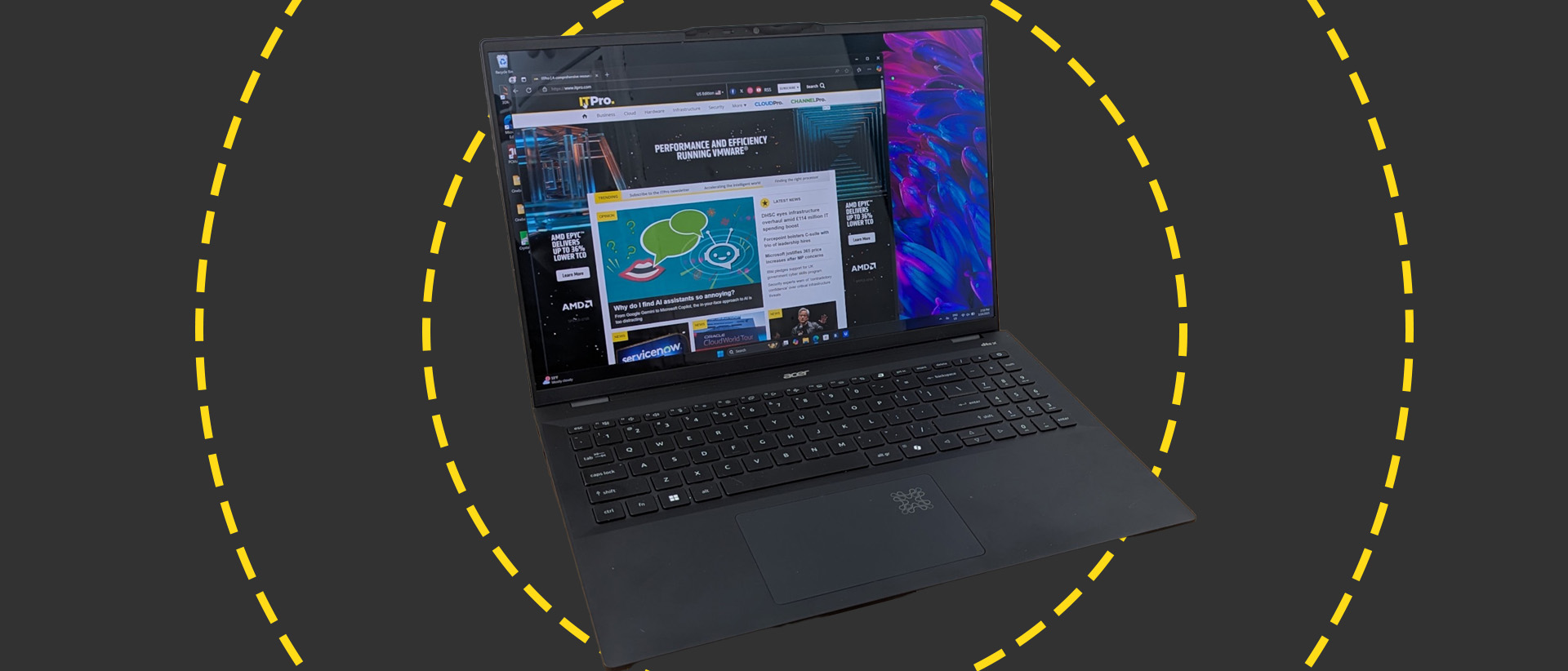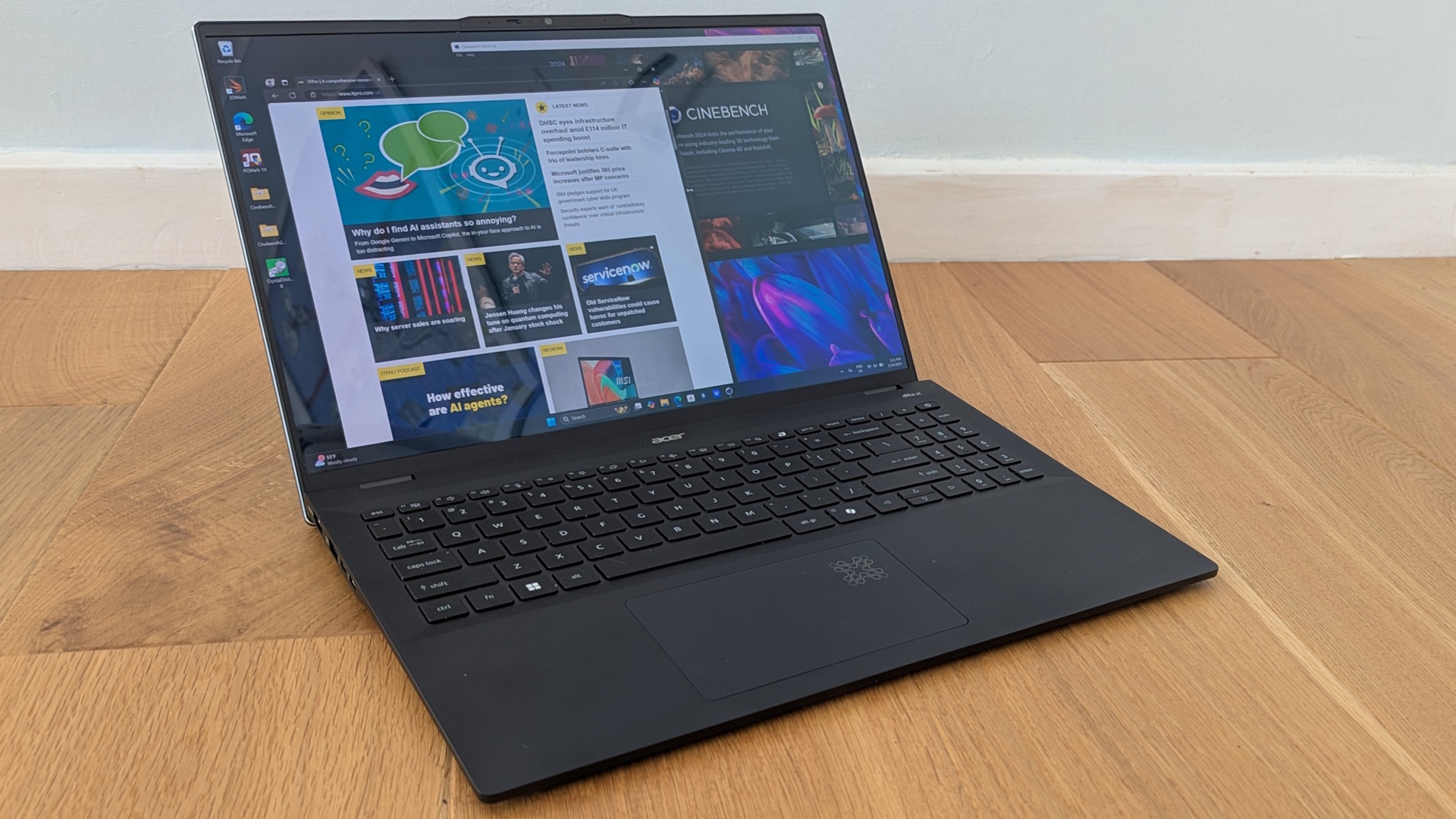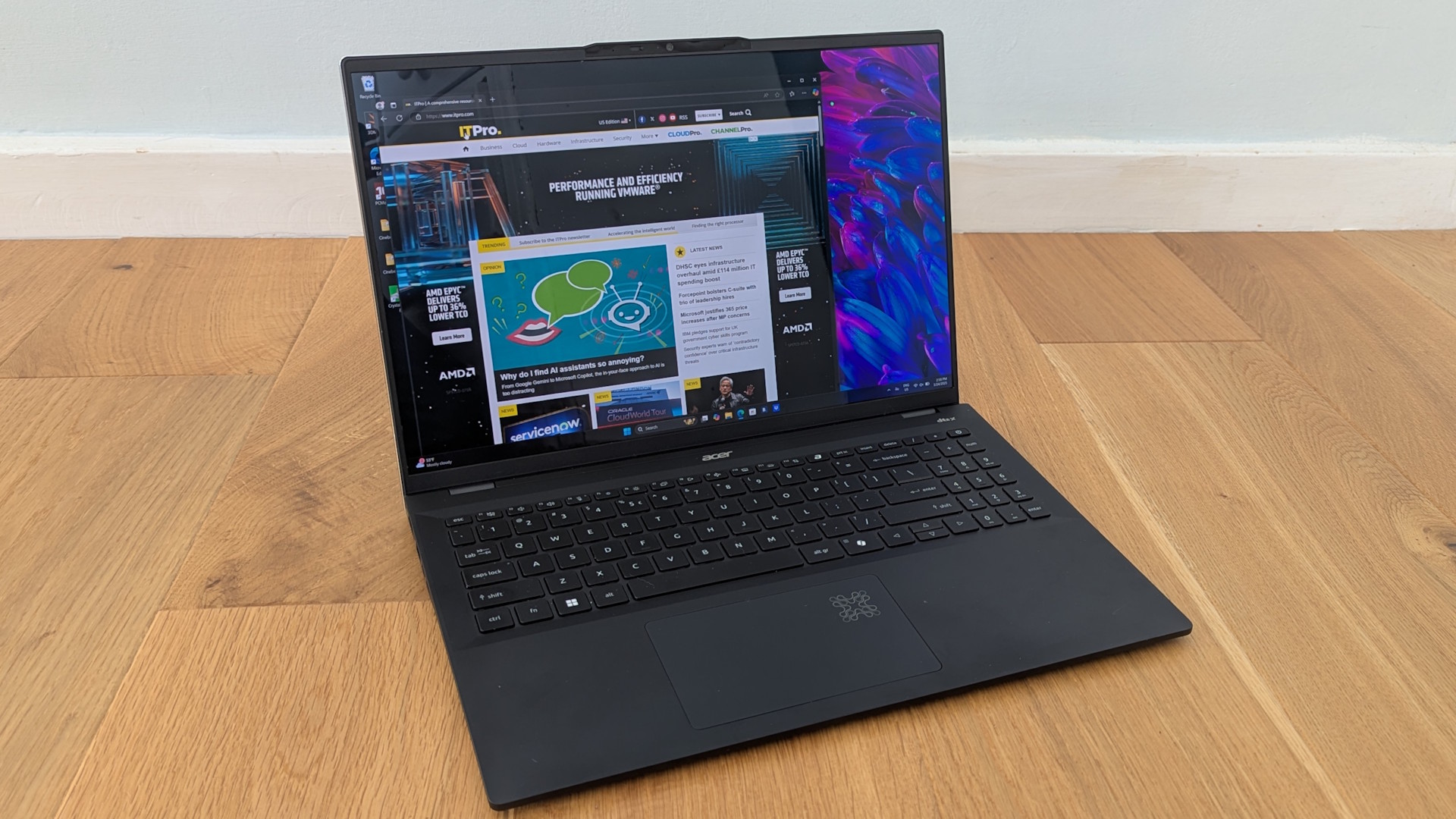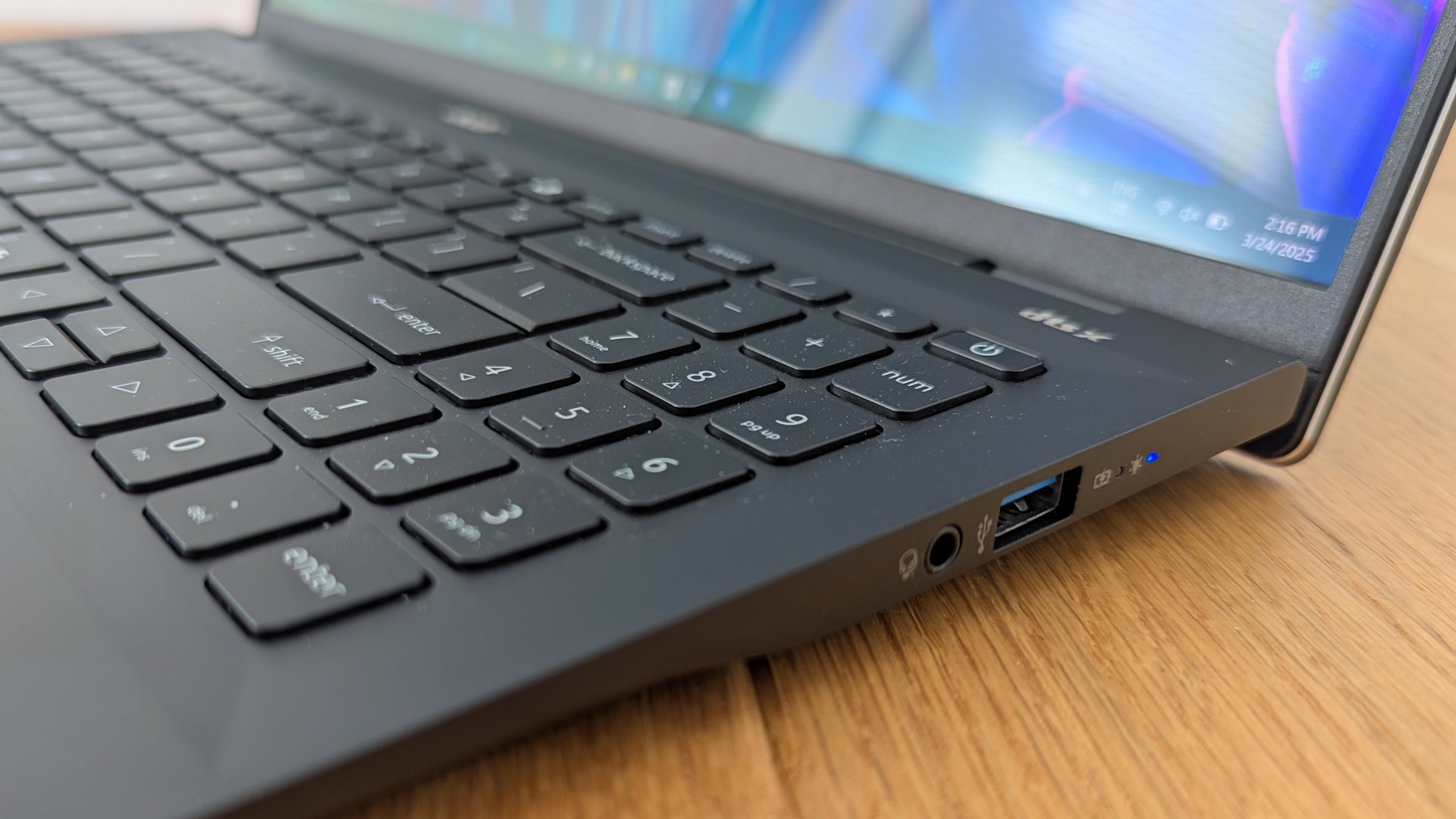Acer Swift 16 AI (SF16-51) review: Versatile and effective
With an excellent 16-inch OLED screen, lightweight design, and good all-round performance, the super-sized Swift is a brilliant generalist laptop, ready for almost any job

-
+
Good mix of CPU, GPU, and NPU performance
-
+
Sleek and light matt black design
-
+
Superb 16-inch OLED screen
-
+
15-hour-plus battery life
-
-
Lunar Lake architecture doesn't compete on multi-threaded performance
-
-
Thin and underwhelming audio

Some enterprise use cases require a certain kind of laptop; something compact, thin-and-light for mobile sales or service teams, or something beefy with a big screen for the software engineers. But what if you need something that can cover a wide range of roles? Here, Acer's new Swift 16 AI could be a great, flexible option, delivering an excellent 16-inch screen and high-end specs at a lower cost than some of its more prestigious competitors.
What's more, it pulls this off with only minor compromises, none seriously impacting usability or performance. Coders, designers, spreadsheet warriors, and anyone who multitasks heavily will find the bigger screen and good all-round performance a real benefit, yet they come without the usual disadvantages of extra bulk and weight. The result is a device that can handle heavy workloads without weighing anyone down.
Acer Swift 16 AI (SF16-51): Design
There's nothing too striking about the Swift 16 AI's design or choice of color. It's a straightforward clamshell design in a matt-black aluminium shell, with a 356 x 249mm footprint. It is, however, fairly slim for a 16-inch laptop, just under 1cm thick at the rear and tapering slightly towards the front, while it weighs under 1.5kg. While it'll take up more space in your bag than your average 13 or 14-inch device, you're not going to notice that much difference while you're carrying it.
The construction is solid, though not quite flawless. The seams on the front-left and front-right edges where the keyboard deck folds over the base are diamond-cut, but protrude slightly and feel rougher than they ought to. There's also a little too much flex in the lid when pressure is applied at the corners, though you would need to put some effort in to cause any serious damage. In any case, the Swift 16 AI is MIL-STD-810 certified for spillage, shock, and dust-resistance, so it doesn't need to be treated with kid gloves.
There are some thoughtful design touches here. The screen hinge mechanism does a nice job of lifting the keyboard up for a more comfortable working position, and you can push it almost flat against the desk should you want to, even if it's hard to fathom exactly why you would. Meanwhile, the camera module sits in a bump at the top of the screen, which also sticks out slightly to make the clamshell easier to open. You can't quite do it single-handed without the body of the laptop rising up, but it's pretty close.

Our review sample shipped with a US layout, but otherwise, there's little to complain about with the keyboard. Acer has used the extra space afforded by the bigger screen to squeeze in a slimline numeric keypad, and there are large Shift, Enter, Tab, and Backspace keys, making up for the Ctrl, Fn, and Alt keys on the left-hand side being standard-sized. The top row of function keys is tiny, however, while it's hard to understand the point of having a separate PrtSc key when it mirrors the Snipping Tool shortcut mapped to F12. It seems rather superfluous.
As for the typing action, it's quiet and slightly spongy rather than fast and clicky, but the actuation is consistent across the board and there's no bounce in the deck or wobble in the individual keys. While not ThinkPad good, it's proved perfectly comfortable over several days of solid use.
The touchpad hits almost all the right notes. At 127 x 78mm, it's big, smooth, and great for handling detailed selections, yet it doesn't occupy space where you'd normally rest your palms while typing. The inlaid AI activity indicator, which pulses gently when the NPU is busy, is more showboating than actually useful, but doesn't have any negative effect on usability. Our only grumble is that it's sometimes over-sensitive when detecting taps, particularly when it comes to opening or closing browser tabs inadvertently. This seemed to happen with the Swift 16 AI more than with any other laptop we've looked at recently.
The Swift 16 AI does well when it comes to future-proof connectivity, with two USB 4.0 Type-C ports, two USB 3.2 gen 1 ports, and an HDMI output. Ideally, we'd have one of the Type-C ports on either side of the laptop for convenient charging, but having the Type-A port and the 3.5mm audio socket on the right makes sense for connecting up a mouse and headset. You've always got Bluetooth 5.4 if you'd prefer wireless peripherals, while there's Wi-Fi 7 onboard to cover the latest and fastest access points and routers.
Acer Swift 16 AI (SF16-51): Display

If there's anything about the Swift 16 AI that will induce envy or amazement from your colleagues, it's the 16-inch OLED display. It's exceptionally vibrant, with SDR brightness levels of over 500cd/m2, with stunning, luminescent colours. The combination of the 16-inch size and 2880 x 1800 resolution is perfect for complex design apps, coding IDEs, or serious multitasking, and the contrast and clarity are almost perfect.
The screen covers 100% of both the sRGB and DCI-P3 colour gamuts and 96.6% of Adobe RGB, while its color accuracy is superb, with an average Delta-E of just 1.03. It's almost wasted on productivity applications and almost begs to be let loose on design, image-editing, or video. All the same, if you can't really appreciate how good it is while you're running Excel or PowerPoint, you'll be more than pleased if you happen to spend a few hours streaming Netflix while away on business.
The Swift 16 AI's camera setup comprises one 1080p webcam and an IR depth camera for Windows Hello face recognition. The Webcam could be sharper, especially in dim daylight or poor artificial lighting, but colors look natural and the exposure well balanced, particularly with the aid of the Windows Studio Effects enhancements. Meanwhile, face recognition is speedy and effective, and there's a fingerprint sensor built into the power key if you'd prefer authentication that way.
The only real disappointment here is the audio. The DTS:X-branded sound system can go loud, and there's no lack of clarity, but the output sounds thin and peaks in the mid-range. While you can clearly hear what's going on in video meetings and calls, you'll want some headphones handy for background music or video streaming.
Acer Swift 16 AI (SF16-51): Performance
The Swift 16 AI is based on the Intel Core Ultra 7 256V processor, combining an 8-core CPU with an 8-core Arc 140V GPU and a 47 TOPS NPU. Our test model shipped with 16GB of LPDDR5 RAM, plus a 1TB PCIe 4.0 SSD for storage.
Intel's Lunar Lake architecture can't match the multithreaded performance of the Qualcomm Snapdragon X Elite and AMD Ryzen 7 and Ryzen 9 AI processors found in some competitor devices, but it's energy efficient and well-balanced. There's enough GPU and NPU performance on offer for some degree of useful local AI processing, while the ARC GPU can also handle a range of 3D graphics and video processing workloads.
In tests, the Swift 16 AI performs very similarly to the Samsung Galaxy Book 5 Pro 360, which uses the same CPU. The Acer has slightly lower single and multi-threaded Geekbench 6 scores of 2723 and 10612 against 2734 and 11037 from the Samsung, while in the PC Mark 10 productivity benchmark, it scores 6782 to the Samsung's 6779. With just eight cores running eight threads and no support for SMT, both laptops struggle to keep up with the Asus Zenbook S16. The latter's 12-core/24-thread Ryzen AI 9 HX 370 helps it hit heights of 2782 and 13508 in Geekbench 6 and 7229 in PC Mark 10. In general use, with regular productivity apps, none of these laptops is going to feel slow.

What's more, the two Intel laptops trade blows with the Asus in 3DMark, with the Swift 16 AI scoring 4139 in the TimeSpy test and 2650 in the newer Steel Nomad Lite test, against 4302 and 2798 from the Galaxy Book 5 Pro 360. The Asus scores 3725 and 3305 in the same tests. There's plenty of GPU performance here to support basic 3D and mainstream creative apps.
Crucially, battery life is surprisingly good for a 16in laptop, with the 69wHr battery lasting 15 hours and 41 minutes in our 1080p video rundown test. The Galaxy Book 5 Pro 360 lasts significantly longer, at 21 hours and 57 minutes, but that's the longest-lasting Windows laptop that we've tested, and the Zenbook S16 kept going for 15 hours and 4 minutes under the same conditions. In practice, we found the Swift 16 AI would easily get us through a long working day, and through most of the morning of the next one.
The 1TB Micron SSD is slightly faster than the average, with sequential read speeds of 5191MB/sec and write speeds of 4653MB/sec. There's a definite sense here that Acer has put together a solid and well-rounded spec that will support a wide range of demanding applications.
Acer Swift 16 AI (SF16-51): Is it worth it?
The comparison with the Samsung is instructive because, while the Swift 16 AI isn't as good in some key aspects, it rights some of the wrongs of the Galaxy Book 5 Pro 360. Both machines offer good all-round performance and fantastic 16-inch OLED screens housed in tasteful thin-and-light designs. But if the Samsung has the edge on battery life and premium build quality, the Swift 16 wins on usability, thanks to a better keyboard, smaller touchpad, and more thought-out ergonomics. It's simply a more comfortable laptop for everyday use.
What's more, it's fantastic value, giving you the feel and speeds of a premium 16-inch laptop at a price point that's more likely to fit within an average SMB's budget. It might not have the flashy styling or creative credentials of some more design-focused devices, but it's equipped to handle the same jobs, while the squarer aspect ratio and high resolution of the screen also make it an effective coding tool. If you're looking for a laptop that can balance portability, power, and all-day working comfort, this is one to seriously consider.
Acer Swift 16 AI (SF16-51) specifications
Display | 16-inch 2,880 x 1,800 OLED, 120Hz refresh rate | Row 0 - Cell 2 |
Processor | Intel Core Ultra 7 256V, 8-core, up to 4.8GHz | Row 1 - Cell 2 |
GPU | Intel Arc 140V | Row 2 - Cell 2 |
RAM | 16GB LPDDR5X | Row 3 - Cell 2 |
Ports | 2x USB4 Type-C, 2x USB 3.2 Gen 1 Type-A, HDMI 2.1 | Row 4 - Cell 2 |
Camera | 1080p webcam with IR and Windows Hello | Row 5 - Cell 2 |
Storage | 1TB PCIe4 SSD (Micron) | Row 6 - Cell 2 |
Connectivity | Wi-Fi 7, Bluetooth v5.4 | Row 7 - Cell 2 |
Weight | 1.46Kg | Row 8 - Cell 2 |
Dimensions | 356 x 249.4 x 9.92mm | Row 9 - Cell 2 |
Battery Capacity | 69Wh | Row 10 - Cell 2 |
Operating System | Windows 11 Home | Row 11 - Cell 2 |
| Row 12 - Cell 0 | Row 12 - Cell 1 | Row 12 - Cell 2 |
Get the ITPro daily newsletter
Sign up today and you will receive a free copy of our Future Focus 2025 report - the leading guidance on AI, cybersecurity and other IT challenges as per 700+ senior executives
Stuart has been writing about technology for over 25 years, focusing on PC hardware, enterprise technology, education tech, cloud services and video games. Along the way he’s worked extensively with Windows, MacOS, Linux, Android and Chrome OS devices, and tested everything from laptops to laser printers, graphics cards to gaming headsets.
He’s then written about all this stuff – and more – for outlets, including PC Pro, IT Pro, Expert Reviews and The Sunday Times. He’s also written and edited books on Windows, video games and Scratch programming for younger coders. When he’s not fiddling with tech or playing games, you’ll find him working in the garden, walking, reading or watching films.
You can follow Stuart on Twitter at @SATAndrews.
-
 M&S suspends online sales as 'cyber incident' continues
M&S suspends online sales as 'cyber incident' continuesNews Marks & Spencer (M&S) has informed customers that all online and app sales have been suspended as the high street retailer battles a ‘cyber incident’.
By Ross Kelly Published
-
 Westcon-Comstor unveils new managed SOC solution for Cisco partners
Westcon-Comstor unveils new managed SOC solution for Cisco partnersNews Powered by Cisco XDR, the new offering will enable partners to tap into new revenue streams, the company said
By Daniel Todd Published
-
 More than 5 million Americans just had their personal information exposed in the Yale New Haven Health data breach – and lawsuits are already rolling in
More than 5 million Americans just had their personal information exposed in the Yale New Haven Health data breach – and lawsuits are already rolling inNews A data breach at Yale New Haven Health has exposed data belonging to millions of people – and lawsuits have already been filed.
By Emma Woollacott Published